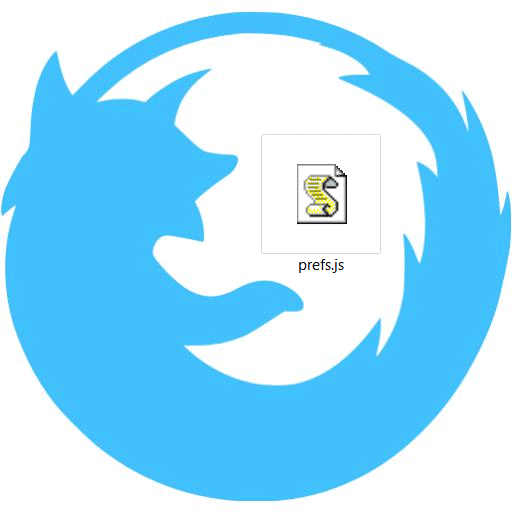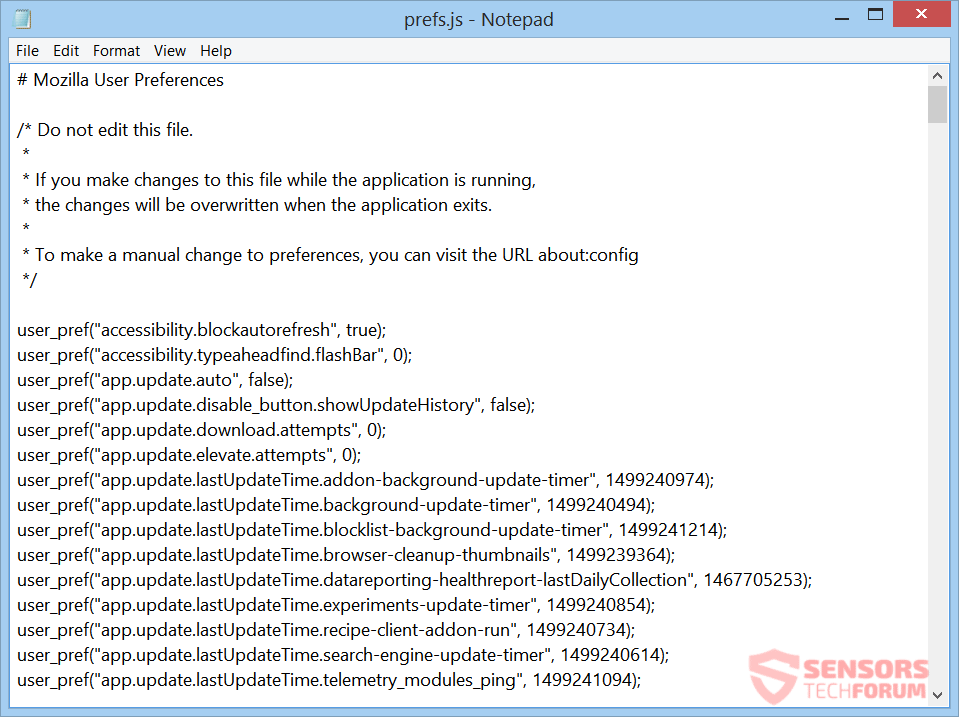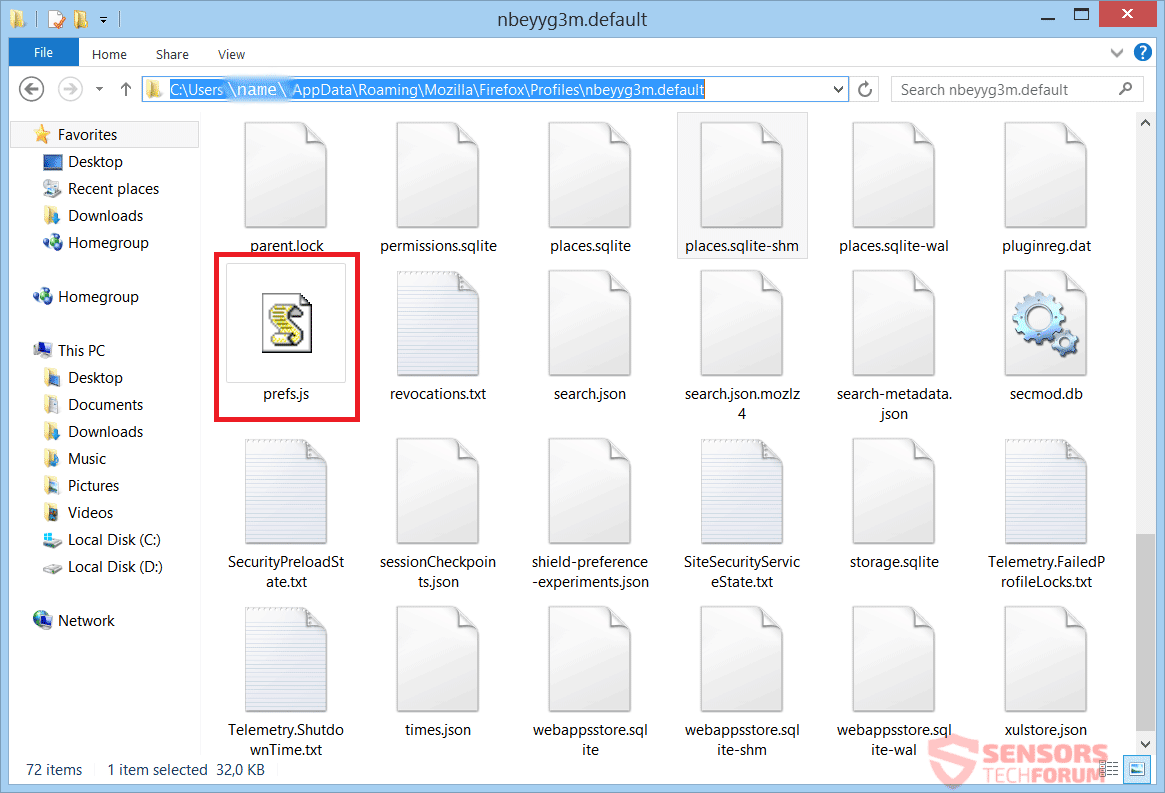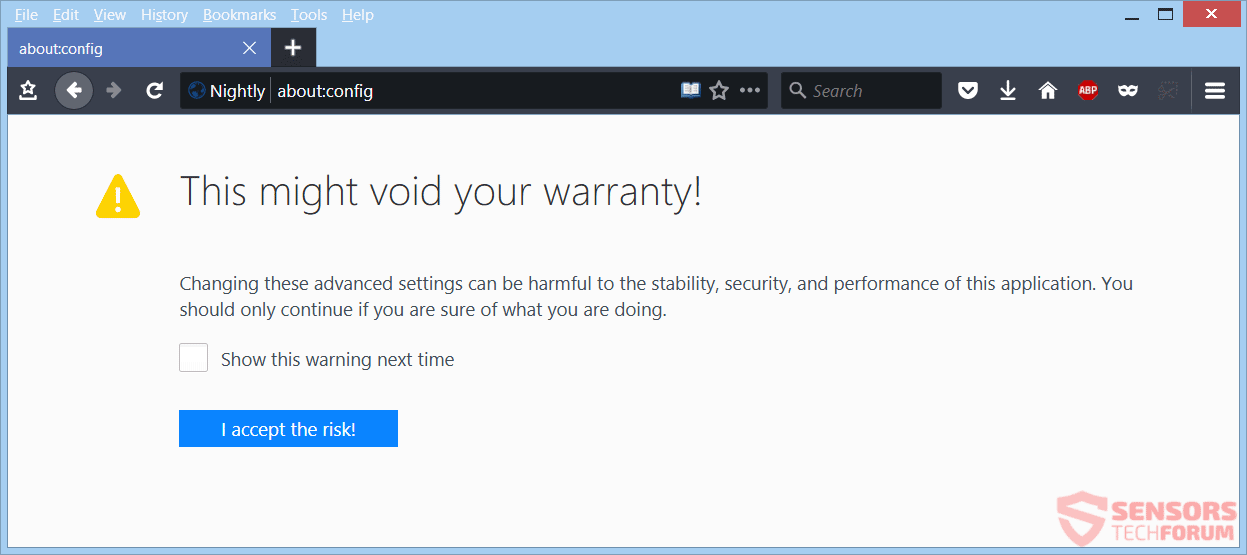
The article will help you understand what is the Prefs.js file and how to remove it if needed. Follow the removal instructions given at the end if you are sure you need to remove it.
What is Prefs.js?
Prefs.js is a completely legitimate file, which is responsible for keeping the preferences for the Mozilla Firefox browser. Those preferences include Privacy settings, along with what theme is in use and for other features to stay turned on or off. As much as this file is important for the browser to run the way you like it, it is also detected by some anti-malware software programs. The reason for those detections is because malware such as a browser hijacker or adware has modified or affected that Prefs.js file and the security tool makes an association between the file and the malware. The most noticeable change you can see when Prefs.js is altered is when you browse you will be redirected or see lots of ads.

Threat Summary
| Name | Prefs.js |
| Type | JavaScript File |
| Short Description | Prefs.js is a legitimate file used by the Mozilla Firefox and browsers based on it. Sometimes AV vendors could detect that file because of scripts, false positives or mainly because the file has been affected by malware. |
| Symptoms | In case the file is modified by malware such as browser hijackers, redirects or adware, some browser settings get changed. The home page, new tab, extensions, themes, privacy settings could be altered. You could experience redirects, lots of new tabs popping up or multiple advertisements showing when you browse and you can’t reverse those settings no matter how you try to save them. |
| Distribution Methods | Freeware Installations, Bundled Packages, Extensions, Malware |
| Detection Tool |
See If Your System Has Been Affected by malware
Download
Malware Removal Tool
|
| User Experience | Join Our Forum to Discuss Prefs.js. |
Prefs.js – What Is It?
Prefs.js is a file that comes with the browser Mozilla Firefox and all its variations and forks, such as Nightly or PaleMoon for instance. That JavaScript file keeps various and mostly all preferences associated with Firefox browsers.
You can preview the contents of the file from the below screenshot:
Look at what is explicitly said in the beginning of that file by the developers of Mozilla Firefox:
# Mozilla User Preferences
/* Do not edit this file.
*
* If you make changes to this file while the application is running,
* the changes will be overwritten when the application exits.
This file is not made to be edited by people who do not know how to do so and what the result will be. You shouldn’t be tampering with it, but probably an application you have installed without realizing has altered the file. That can be easily spotted if you witness changes in preferences and tweaks of your browser.
The following settings and preferences are contained in Prefs.js:
- Themes
- Home page
- Download location for files
- Toggle for remembering passwords
- History settings (as is it “saved” or not)
- Incognito mode settings
- Other tracking settings
- Sending Reports and Telemetry setting
- Update settings
As you can see above, that is quite a long list and it will take you a while to change those settings back if needed. Installing an extension could modify those preferences to something you don’t want.
Where Is This File Located?
The Prefs.js is located on your computer on one of your disk drives. By knowing its location you can open it with notepad, make changes, try to restore previous versions, or switch it with a new Prefs.js file to make sure it is clean.
The following Windows command is used to access a folder which contains another, randomly named folder to finally reach the Prefs.js file:
→%APPDATA%\Mozilla\Firefox\Profiles\
That command will open a folder, which has only one sub-folder, containing lots of files related to the browser, including the Prefs.js file itself. You can see the contents of that sub-folder right down here in the picture:
The full directory in this case is:
→C:\Users\{name}\AppData\Roaming\Mozilla\Firefox\Profiles\nbeyyg3m.default\Prefs.js
Another way to access the file, or to make changes inside it rather, is by typing about:config into your browser. However, that will show the following warning page, before unlocking the page with the actual code:
The text states the following:
This might void your warranty!
Changing these advanced settings can be harmful to the stability, security, and performance of this application. You should only continue if you are sure of what you are doing.
Also, if you go into the directory and open the file, there will be another warning inside, which we mentioned above when describing the contents of Prefs.js. Make sure you know what you are doing, before making any changes or make a copy of the file beforehand so you have a backup if you mess things up and want to restore it.
Prefs.js – Why Is It Detected by Security Tools?
Prefs.js is detected by Anti-malware and security tools only in the case that the file is somehow connected to malware. That can happen in various ways, but it is certainly an indication of the file being tampered with or directly affected by some form of malware. In most cases that malware is a browser hijacker, redirect or adware.
The adware spams you with advertisements, which can cover the whole page; they can be triggered upon clicking on specific locations on a page, including links; or appear as pop-ups and on the side of pages on a website. The redirect is simply made to modify the browser so redirects you when a certain action is met, or from every single link and tab. The browser hijacker can be a combination of adware with redirects or something in a milder form. In all cases, that is not only highly annoying but could end up having a serious impact on your browsing and work.
If you have any doubts or see any of the above-mentioned symptoms you should immediately check your browsers and computer systems for any suspicious software and also do a scan with a security tool.

Should You Remove Prefs.js?
There is no real harm in manually locating the file and straight out deleting it. Your browser, be it the original Firefox, one of its other official editions or a fork written on the same code, will still save your Bookmarks and Add-ons. Besides, any Firefox browser will create a new Prefs.js on its launch and any new changes will be saved on it, afterwards.
Here are browsers which use the file:
- Mozilla Firefox
- Nightly
- Aurora
- PaleMoon
- Waterfox
- Comodo IceDragon
- xB Browser
- Flock
All of the browser builds elicited above will have a Prefs.js, while some may put it inside the main drive they are installed on. You should just type the name of the file and do a search if it’s not found in its usual place.
In case you do not want to lose any of the preferences saved by that file or there is seemingly some malware on your system that keeps modifying the file, you should consider scanning your system by following the step-by-step removal instructions provided below. If the manual removal does not get rid of the malware causing the changes and its files completely, you should search for and remove any leftovers with an advanced anti-malware tool. Such a tool can keep your computer safe in the future.
- Windows
- Mac OS X
- Google Chrome
- Mozilla Firefox
- Microsoft Edge
- Safari
- Internet Explorer
- Stop Push Pop-ups
How to Remove Prefs.js from Windows.
Step 1: Scan for Prefs.js with SpyHunter Anti-Malware Tool



Step 2: Boot Your PC In Safe Mode





Step 3: Uninstall Prefs.js and related software from Windows
Uninstall Steps for Windows 11



Uninstall Steps for Windows 10 and Older Versions
Here is a method in few easy steps that should be able to uninstall most programs. No matter if you are using Windows 10, 8, 7, Vista or XP, those steps will get the job done. Dragging the program or its folder to the recycle bin can be a very bad decision. If you do that, bits and pieces of the program are left behind, and that can lead to unstable work of your PC, errors with the file type associations and other unpleasant activities. The proper way to get a program off your computer is to Uninstall it. To do that:


 Follow the instructions above and you will successfully uninstall most programs.
Follow the instructions above and you will successfully uninstall most programs.
Step 4: Clean Any registries, Created by Prefs.js on Your PC.
The usually targeted registries of Windows machines are the following:
- HKEY_LOCAL_MACHINE\Software\Microsoft\Windows\CurrentVersion\Run
- HKEY_CURRENT_USER\Software\Microsoft\Windows\CurrentVersion\Run
- HKEY_LOCAL_MACHINE\Software\Microsoft\Windows\CurrentVersion\RunOnce
- HKEY_CURRENT_USER\Software\Microsoft\Windows\CurrentVersion\RunOnce
You can access them by opening the Windows registry editor and deleting any values, created by Prefs.js there. This can happen by following the steps underneath:


 Tip: To find a virus-created value, you can right-click on it and click "Modify" to see which file it is set to run. If this is the virus file location, remove the value.
Tip: To find a virus-created value, you can right-click on it and click "Modify" to see which file it is set to run. If this is the virus file location, remove the value.
Video Removal Guide for Prefs.js (Windows).
Get rid of Prefs.js from Mac OS X.
Step 1: Uninstall Prefs.js and remove related files and objects





Your Mac will then show you a list of items that start automatically when you log in. Look for any suspicious apps identical or similar to Prefs.js. Check the app you want to stop from running automatically and then select on the Minus (“-“) icon to hide it.
- Go to Finder.
- In the search bar type the name of the app that you want to remove.
- Above the search bar change the two drop down menus to “System Files” and “Are Included” so that you can see all of the files associated with the application you want to remove. Bear in mind that some of the files may not be related to the app so be very careful which files you delete.
- If all of the files are related, hold the ⌘+A buttons to select them and then drive them to “Trash”.
In case you cannot remove Prefs.js via Step 1 above:
In case you cannot find the virus files and objects in your Applications or other places we have shown above, you can manually look for them in the Libraries of your Mac. But before doing this, please read the disclaimer below:



You can repeat the same procedure with the following other Library directories:
→ ~/Library/LaunchAgents
/Library/LaunchDaemons
Tip: ~ is there on purpose, because it leads to more LaunchAgents.
Step 2: Scan for and remove Prefs.js files from your Mac
When you are facing problems on your Mac as a result of unwanted scripts and programs such as Prefs.js, the recommended way of eliminating the threat is by using an anti-malware program. SpyHunter for Mac offers advanced security features along with other modules that will improve your Mac’s security and protect it in the future.
Video Removal Guide for Prefs.js (Mac)
Remove Prefs.js from Google Chrome.
Step 1: Start Google Chrome and open the drop menu

Step 2: Move the cursor over "Tools" and then from the extended menu choose "Extensions"

Step 3: From the opened "Extensions" menu locate the unwanted extension and click on its "Remove" button.

Step 4: After the extension is removed, restart Google Chrome by closing it from the red "X" button at the top right corner and start it again.
Erase Prefs.js from Mozilla Firefox.
Step 1: Start Mozilla Firefox. Open the menu window:

Step 2: Select the "Add-ons" icon from the menu.

Step 3: Select the unwanted extension and click "Remove"

Step 4: After the extension is removed, restart Mozilla Firefox by closing it from the red "X" button at the top right corner and start it again.
Uninstall Prefs.js from Microsoft Edge.
Step 1: Start Edge browser.
Step 2: Open the drop menu by clicking on the icon at the top right corner.

Step 3: From the drop menu select "Extensions".

Step 4: Choose the suspected malicious extension you want to remove and then click on the gear icon.

Step 5: Remove the malicious extension by scrolling down and then clicking on Uninstall.

Remove Prefs.js from Safari
Step 1: Start the Safari app.
Step 2: After hovering your mouse cursor to the top of the screen, click on the Safari text to open its drop down menu.
Step 3: From the menu, click on "Preferences".

Step 4: After that, select the 'Extensions' Tab.

Step 5: Click once on the extension you want to remove.
Step 6: Click 'Uninstall'.

A pop-up window will appear asking for confirmation to uninstall the extension. Select 'Uninstall' again, and the Prefs.js will be removed.
Eliminate Prefs.js from Internet Explorer.
Step 1: Start Internet Explorer.
Step 2: Click on the gear icon labeled 'Tools' to open the drop menu and select 'Manage Add-ons'

Step 3: In the 'Manage Add-ons' window.

Step 4: Select the extension you want to remove and then click 'Disable'. A pop-up window will appear to inform you that you are about to disable the selected extension, and some more add-ons might be disabled as well. Leave all the boxes checked, and click 'Disable'.

Step 5: After the unwanted extension has been removed, restart Internet Explorer by closing it from the red 'X' button located at the top right corner and start it again.
Remove Push Notifications from Your Browsers
Turn Off Push Notifications from Google Chrome
To disable any Push Notices from Google Chrome browser, please follow the steps below:
Step 1: Go to Settings in Chrome.

Step 2: In Settings, select “Advanced Settings”:

Step 3: Click “Content Settings”:

Step 4: Open “Notifications”:

Step 5: Click the three dots and choose Block, Edit or Remove options:

Remove Push Notifications on Firefox
Step 1: Go to Firefox Options.

Step 2: Go to “Settings”, type “notifications” in the search bar and click "Settings":

Step 3: Click “Remove” on any site you wish notifications gone and click “Save Changes”

Stop Push Notifications on Opera
Step 1: In Opera, press ALT+P to go to Settings.

Step 2: In Setting search, type “Content” to go to Content Settings.

Step 3: Open Notifications:

Step 4: Do the same as you did with Google Chrome (explained below):

Eliminate Push Notifications on Safari
Step 1: Open Safari Preferences.

Step 2: Choose the domain from where you like push pop-ups gone and change to "Deny" from "Allow".
Prefs.js-FAQ
What Is Prefs.js?
The Prefs.js threat is adware or browser redirect virus.
It may slow your computer down significantly and display advertisements. The main idea is for your information to likely get stolen or more ads to appear on your device.
The creators of such unwanted apps work with pay-per-click schemes to get your computer to visit risky or different types of websites that may generate them funds. This is why they do not even care what types of websites show up on the ads. This makes their unwanted software indirectly risky for your OS.
What Are the Symptoms of Prefs.js?
There are several symptoms to look for when this particular threat and also unwanted apps in general are active:
Symptom #1: Your computer may become slow and have poor performance in general.
Symptom #2: You have toolbars, add-ons or extensions on your web browsers that you don't remember adding.
Symptom #3: You see all types of ads, like ad-supported search results, pop-ups and redirects to randomly appear.
Symptom #4: You see installed apps on your Mac running automatically and you do not remember installing them.
Symptom #5: You see suspicious processes running in your Task Manager.
If you see one or more of those symptoms, then security experts recommend that you check your computer for viruses.
What Types of Unwanted Programs Are There?
According to most malware researchers and cyber-security experts, the threats that can currently affect your device can be rogue antivirus software, adware, browser hijackers, clickers, fake optimizers and any forms of PUPs.
What to Do If I Have a "virus" like Prefs.js?
With few simple actions. First and foremost, it is imperative that you follow these steps:
Step 1: Find a safe computer and connect it to another network, not the one that your Mac was infected in.
Step 2: Change all of your passwords, starting from your email passwords.
Step 3: Enable two-factor authentication for protection of your important accounts.
Step 4: Call your bank to change your credit card details (secret code, etc.) if you have saved your credit card for online shopping or have done online activities with your card.
Step 5: Make sure to call your ISP (Internet provider or carrier) and ask them to change your IP address.
Step 6: Change your Wi-Fi password.
Step 7: (Optional): Make sure to scan all of the devices connected to your network for viruses and repeat these steps for them if they are affected.
Step 8: Install anti-malware software with real-time protection on every device you have.
Step 9: Try not to download software from sites you know nothing about and stay away from low-reputation websites in general.
If you follow these recommendations, your network and all devices will become significantly more secure against any threats or information invasive software and be virus free and protected in the future too.
How Does Prefs.js Work?
Once installed, Prefs.js can collect data using trackers. This data is about your web browsing habits, such as the websites you visit and the search terms you use. It is then used to target you with ads or to sell your information to third parties.
Prefs.js can also download other malicious software onto your computer, such as viruses and spyware, which can be used to steal your personal information and show risky ads, that may redirect to virus sites or scams.
Is Prefs.js Malware?
The truth is that PUPs (adware, browser hijackers) are not viruses, but may be just as dangerous since they may show you and redirect you to malware websites and scam pages.
Many security experts classify potentially unwanted programs as malware. This is because of the unwanted effects that PUPs can cause, such as displaying intrusive ads and collecting user data without the user’s knowledge or consent.
About the Prefs.js Research
The content we publish on SensorsTechForum.com, this Prefs.js how-to removal guide included, is the outcome of extensive research, hard work and our team’s devotion to help you remove the specific, adware-related problem, and restore your browser and computer system.
How did we conduct the research on Prefs.js?
Please note that our research is based on independent investigation. We are in contact with independent security researchers, thanks to which we receive daily updates on the latest malware, adware, and browser hijacker definitions.
Furthermore, the research behind the Prefs.js threat is backed with VirusTotal.
To better understand this online threat, please refer to the following articles which provide knowledgeable details.




